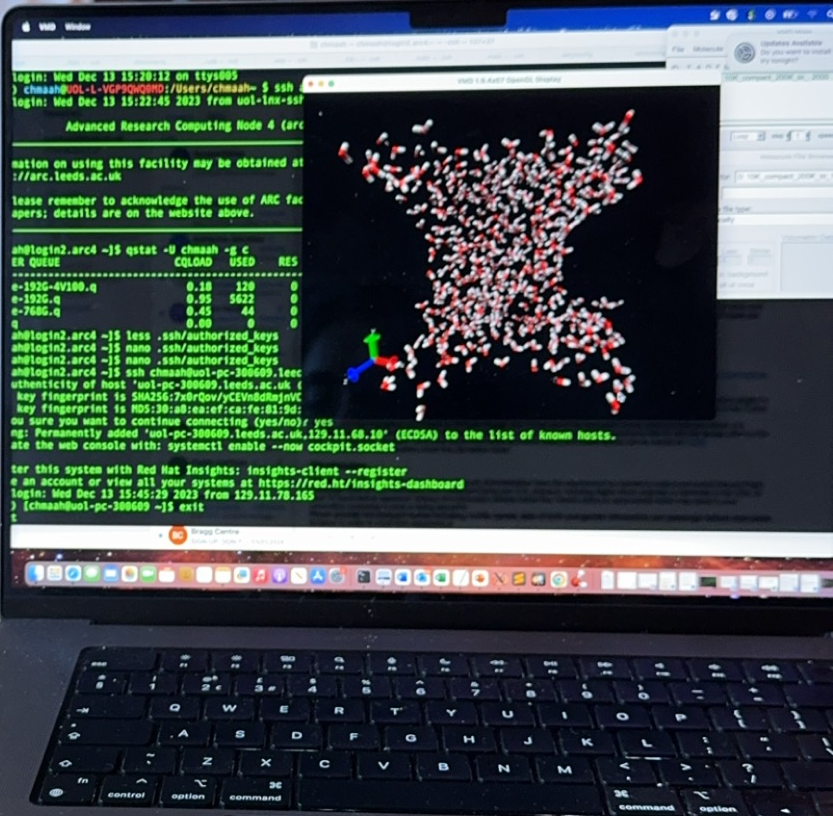Current Research Interests
Non-Thermal Desorption and Binding Energy Computations of Interstellar Ices
Background
Stars and their surrounding planetary systems form within dense molecular clouds. During the gravitational collapse of these clouds, dust and gas flows through a collapsing envelope, feeding a so-called protoplanetary disk, providing the material required to form a new planetary system.[1]
The cold midplane of protoplanetary disks is seeded with ices that originally formed on dust grains at the low densities (10³ – 10⁴ cm⁻³) and temperatures (10 K) in the parent molecular cloud.[2] Infrared ices subsequently react with atomic hydrogen to form larger and more complex species such as CH₂O and CH₃OH, the processing of which via heat and/or radiation can further enhance the chemical complexity of interstellar ices.[3]
The presence of complex organic molecules (in the form of gas-phase methanol) in protoplanetary disks have finally been revealed around young stars in observations with ALMA (the Atacama Large Millimeter/submillimeter Array);[4] methanol is found to be rotationally cold and likely arising from non-thermal desorption from the cold icy reservoir in the disk midplane. The confirmation of methanol in protoplanetary disks has revealed the presence of a complex organic ice reservoir in disk midplanes for the first time. This reservoir may be processed to form molecules of higher complexity, the rates of which depend on the binding energies and binding environments of key radicals under the conditions in disk midplanes.[5]
I currently model amorphous solid water (ASW) and methanol ices, as well as mixed water-methanol ices at the following temperatures; 10 K, 20 K, 50 K, and 70 K (protoplanetary disk temperatures), yielding a range of interstellar ices. I conduct binding and non-thermal desorption investigations of these complex molecular systems using a range of QM (quantum mechanical), MM (molecular mechanical) and semi-empirical methods.
[1] E. F. van Dishoeck et al. arXiv Astro-ph.EP (2020).
[2] J. K. Jørgensen, et al. Ann Rev of Astron. Astrophys. 58 (2020): 727-778.
[3] K. I. Öberg, Chem Rev 116 (2016): 9631−9663.
[4] C. Walsh, et al. ApJ Letters 823 (2016): L10
[5] A. S. Booth, et al., Nature Astron 5 684-690 (2021)
Research Projects
-

Jet Fuel Autooxidation
University of Sheffield,
supervised by Professor Anthony J.H.M. Meijer. Project completion date, 2017
-

Quantum Soil Modelling
University of Sheffield,
supervised by Dr Natalia Martsinovich and Dr Adrien Chauvet. Project completion date, 2021
-

Programming Solubility Project
University of Leeds,
supervised by Professor Bao Nguyen. Project completion date, 2022
-

Protoplanetary Disc Ices
University of Leeds,
PI Associate Professor Dr Catherine Walsh. 2022 - present
Publications
Ahmad, A. et al. Theoretical Determination of the Binding Energies of Methanol Species onto Interstellar Ices (in prep)
Ahmad, A. et al. Theoretical Determination of the Binding Energies of Complex Organic Molecule Species onto CO2 Interstellar Ice surfaces (in prep)
Ahmad, A. et al. Methanol in the Icy Universe (in prep)
Collaborations
Building amorphous solid water (ASW) ices with GROMACs - Collaboration with Dr. Helen Fraser & Dr Zachary Amato (Open University, Uk)
Binding energy studies of organic molecules to intermolecular ices - Collaboration with Associate Professor Dr. Stefan Vogt-Geisse (University of Concepción, Chile)
Surface diffusion in molecular astrophysics and planetary science - Collaboration led by Dr Neils Ligterink (TU Delft, Netherlands)
Master’s student Project
Binding energy studies of CO2 ice surfaces - student: A. Lala
